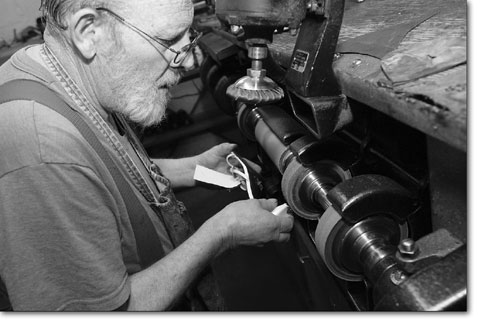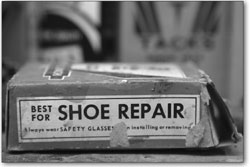|
|
||||||
|
Seventy-seven years of shoes
by Jeff Mannix
The shop chose the name Landis over Gianconelli in honor of the Landis Machine Co., makers of the revolutionary Landis Wax Thread Lock-Stitch Sewing Machine, circa 1893. Other small shoe repair shops across the country also were changing their names to Landis Shoe & Boot Repair, and Giaconelli availed himself of the offer. Benches were built, materials ordered, machines delivered and a sign was made. And 77 years later, Durango still has a shoe, boot and harness repair shop that has outlasted every competitor and all but a handful of other businesses in town. Charles Thomas, Giaconelli’s stepson, moved from his grandparents’ home in Silverton to live with his new family above the shoe repair shop when he was in grade school. He worked in the shop and apprenticed his skills with leather repair. He moved away but was summoned home when his stepfather fell ill, taking over Landis Shoe & Boot in the mid 1960s – a post he held until his death in 1999. Landis Shoe & Boot Repair survives today with Thomas’ wife, Amy, running the front of the shop, and Dick Adcock and Mervin Stilson plying the trade. Shoe repair would seem to be a dying business these days with footwear manufacturing having long since departed for Asia and the proliferation of rubber sport shoes and cheap, throw-away shoes made of plastics and faux leather. But Amy Thomas says that while the industry certainly has changed, Landis is still doing well. “We have a regular trade that has been coming in for years, even generations,” Thomas says, “some as far away as Telluride, Pagosa Springs and Farmington. And we’re always seeing new folks who move to town, nice people with very nice shoes they’ve taken care of where they4 used to live.” A lot more women’s shoes come in for repair than used to, Thomas notes, and they now pass up the volume of men’s shoes. But there has always been and continues to be a healthy business in cowboy and other work boots. “A good pair of boots are expensive, as are good women’s shoes,” Thomas says matter-of-factly. “It pays to take care of them, and we do that for our customers.” Landis Shoe & Boot Repair moved from Main Avenue to its present location on Highway 160 West in 1982, the same year Amy came to work for her husband. The workshop is 18 steep steps beneath the front counter, so Amy was conscripted to greet the customers while Charles repaired the incoming in the basement. “It’s not the best design for a shoe repair shop,” Thomas chuckles. “But it’s worked for 23 years, and it put me in a business I had no intention of being in. You can’t keep walking up and down those stairs when a customer comes in, so Charlie made my job sound easy.” Thomas almost immediately fell victim to “job creep” and was soon doing the books, ordering supplies and becoming expert at diagnosing repair needs and costs. “Charlie was never much interested in the book work,” Amy states with a resignation tinged with love. “He didn’t like it, piled it up on the desk. He was a man who worked with his hands, so I took over the paperwork and learned the business side of things while Charlie did the nailing, stitching and gluing. “It’s a good thing, too,” she adds. “When Charlie died we kept right on serving our customers.”
“It’s a good thing, too,” she adds. “When Charlie died we kept right on serving our customers.” That was possible because of Dick Adcock. Adcock became apprentice to Charles Thomas in January of 1970. Twenty-four years old then, he’s still repairing shoes and boots at Landis 35 years later. “He’s the most dependable, honest and cheerful man in the world,” Thomas says with an almost motherly pride. Adcock loves his work and says that he’s a lucky man to have been taught the trade by Chuck Thomas. “Chuck knew everything there was to know about fixing boots and shoes,” Adcock says without stopping work. “He was the only one around who was licensed to work on orthopedic prescriptions, you know the shoes built for people with polio or missing toes, that kind of stuff. He’d get shoes sent to him from all over. He was good, real good.” Adcock works on a number of shoes or boots simultaneously, waiting for glue to dry or stain to set. His hands are strong, fingers blackened, nails hardened like iron. He’s in no hurry, but he’s not slow. Quality is his goal, as it is with every true craftsman, and the pleasure of his customers is what keeps Adcock coming to work every day. “I’m happy when the customers are pleased with my work,” Adcock says as he sizes a thick piece of leather that will fit seamlessly as a sole on a handsome pair of cowboy boots. “You can shrink the size of a boot if you don’t put a sole on right, did you know that? “Have you ever had your boots or shoes resoled and had them fit tight and had to walk around for a while like they was soled with wood?” he asks rhetorically. “Well I’ve got customers who have told me that they’ve walked off with a pair of my new soles and never even felt that they’d been touched.” Dick arches an eyebrow and a twinkle flashes in his blue eyes. The more you watch a shoe repairman work the more you realize that shoe repair is more of a craft than a trade. Tradesmen are plumbers, mechanics, electricians, roofers and builders. But shoe repairmen need a touch, have some extra instinct, rely on tricks of the trade to please a customer who knows intimately any change to the fit and feel of his footwear. “People get attached to their shoes or boots,” Adcock says knowingly. Working alongside Adcock is Mervin Stilson, 50, who has repairing and making shoes and boots since he was 15. Like Adcock, Stilson remembers with reverence the man with whom he apprenticed. But unlike Adcock, who worked himself into a satisfying job, Stilson was called to the craft as a youngster in an orphanage in Troy, N.Y. “There’d be boxes of kids’ shoes waiting to be repaired, and boxes coming back from repair,” he says wistfully, “and I remember sitting in the closet all by myself studying the difference, looking at what was needed and what was done.” Stilson got some trade books to better understand the inside of a shoe and eventually landed a job at Troy Quick Shoe Repair. By day he performed the grunt work at the shop, but by night he built his first pair of boots – from a book. “I’d bring my boots to the shop in the morning to use the tools. I didn’t have it all wrong, but then you just can’t get it all right from a book,” Stilson says with a dismissive shrug. Stilson went on to apprentice in custom boot making with the reputable mountain bootmaker Limmer & Sons in Intervale, N.H. It was here that Stilson learned the tricks of the trade and the pride in workmanship that Adcock had learned with Charles Thomas. “I have an attitude about footwear, no doubt about it,” says Stilson with a cocky squaring of the shoulders. Asked why they’ve dedicated their working lives to shoe repair, Adcock drawls, “I like it.” Stilson answers, “Maybe it’s the glue.”
|
In this week's issue...
- December 18, 2025
- Let it snow
Although ski areas across the West have taken a hit, there’s still hope
- December 18, 2025
- Look, but don't take
Lessons in pottery theft – and remorse – from SW Colorado
- December 11, 2025
- Big plans
Whole Foods, 270 apartments could be coming to Durango Mall parcel



 ondo Giaconelli, Italian immigrant and the son of the
son of a cobbler, opened Landis Shoe & Boot Repair in Durango
in 1928. At that time, the shop was located on the west side of the
600 block of Main Avenue, the present site of Francisco’s
Restaurante Y Cantina.
ondo Giaconelli, Italian immigrant and the son of the
son of a cobbler, opened Landis Shoe & Boot Repair in Durango
in 1928. At that time, the shop was located on the west side of the
600 block of Main Avenue, the present site of Francisco’s
Restaurante Y Cantina.
